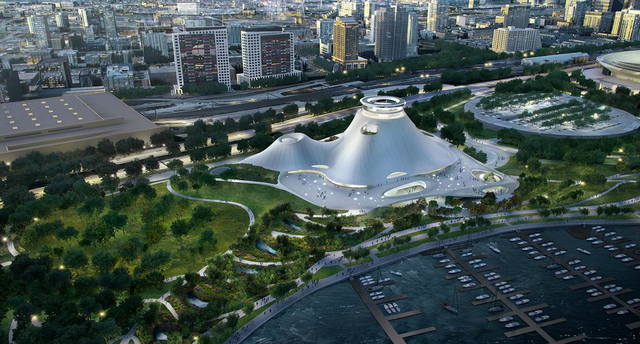CHICAGO (AP) — The team behind George Lucas’ art and movie museum released revised renderings showing more green space at the Chicago site but no radical changes to the undulating, futuristic building stoking passions in a city that guards its
CHICAGO (AP) — The team behind George Lucas’ art and movie museum released revised renderings showing more green space at the Chicago site but no radical changes to the undulating, futuristic building stoking passions in a city that guards its Lake Michigan shoreline with religious-like devotion.
Images that will be presented to City Council next week show designers have significantly shrunk the lakefront building while preserving a smooth, tapering, dune-like form topped with an observation deck resembling a floating disc — a shape that critics have compared to Jabba the Hutt. Defenders of what will be known as the Lucas Museum of Narrative Art, including Mayor Rahm Emanuel, have said the design is loyal to Chicago’s history of making bold architectural statements and its devotion to keeping the lakefront open, accessible and green.
“Currently, it’s a vast asphalt parking lot that is not welcoming; it’s not very green,” museum President Don Bacigalupi said of the site to the south of Soldier Field, home of the Chicago Bears. “And so replacing that with both a museum that’s an amenity, that’s an attraction and an educational inspiration, plus this very new green space park … that’s really our goal.”
The 17-acre site will erase the parking lot and add 4.5 acres of new parkland.
A group committed to preserving open space, especially along the Lake Michigan shoreline, has fought the museum’s location out of concern it opens the way for more construction on the valuable ribbon of public, open land. In a lawsuit currently in federal court, it says the city has no authority to hand over the land, citing a legal principle known as the public trust doctrine, which requires the state to ensure open spaces are preserved and accessible to the public.
The design revisions unveiled Thursday were not an attempt to appease critics. Rather, as more planning went into the interior space, the exterior changed, Bacigalupi said. The original building was scaled back from 400,000 to 300,000 square feet, allowing for more park space.
That space will include an “event prairie” and expanses of trees and native plantings to attract birds and other wildlife, as well as layers of pools designed to filter storm runoff.
Its designers, architects Jeanne Gang and Kate Orff, said they wanted the space to function as educational “green infrastructure,” while providing an inspiring gateway to the museum rising in the distance.
The design is essentially final, although there could be minor adjustments. Construction is expected to begin in March and last until 2018.
It features an open-air observation deck on the rooftop, accessible for free by a ramp winding up the building’s interior cone shape.
An outdoor plaza in front gently rolls upward into the sloping face of the building.
“It reminds you of the sand dune landscape that had been there on the lakefront a long time ago,” said architect Ma Yansong. “So it’s very organic architecture.”
The museum will showcase popular art Lucas has collected since college, including illustrations by Norman Rockwell, Maxfield Parrish and N.C. Wyeth, as well as works by Lucas’s visual effects company, Industrial Light and Magic.
It also will feature digital media arts and film industry art, including props, costumes, set pieces and story boards. Three auditoriums will host films, lectures and workshops. And there’s an educational library.
The vision is to highlight art that tells a story. The collection will have “Star Wars” and “Indiana Jones” fans mingling with art connoisseurs, Bacigalupi said.




